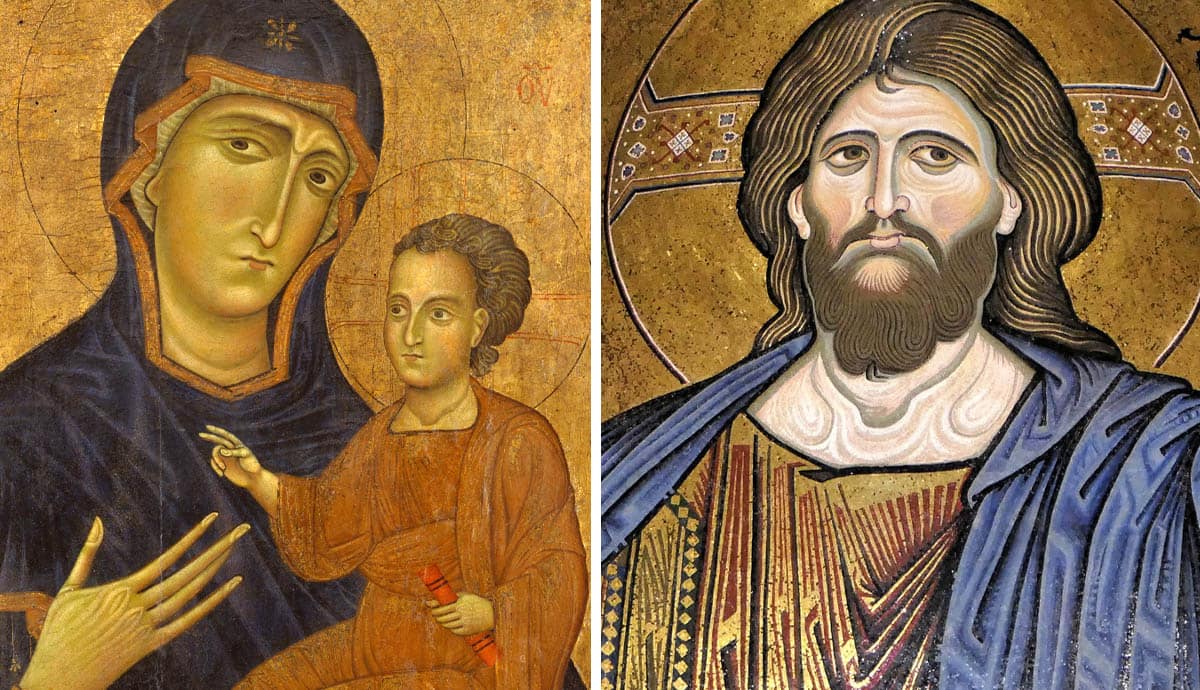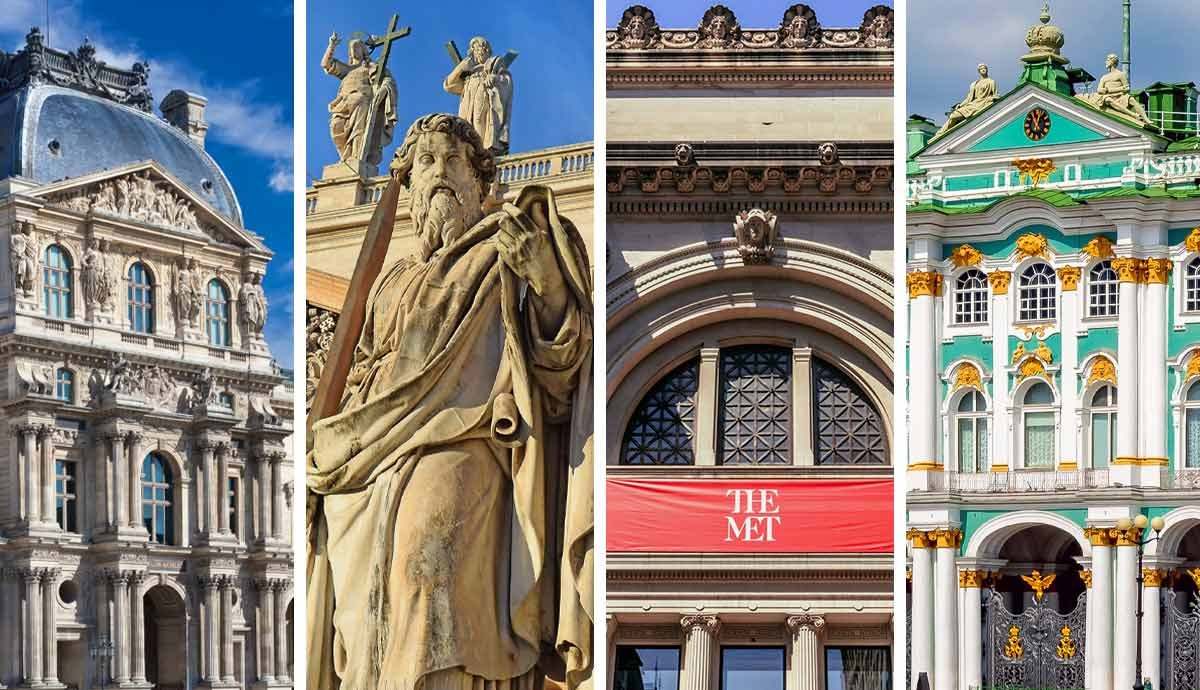
The long-lived Byzantine Empire was famous for its religious art, primarily monumental, glittering mosaics and small-scale, devotional panel paintings. Its capital in Constantinople (now Istanbul, Turkey) was also the chief city of the Orthodox branch of the Christian faith, which is practiced today in parts of eastern Europe, the Middle East, and Africa. The religious iconography used in Byzantine art was very consistent; it used much the same conventions across the centuries, despite variations in artistic style. However, it may seem foreign to fans of western European medieval art, particularly because of the Greek names (Greek was the official language of the Byzantine Orthodox church, just as Latin was the official language of the medieval western European church).
With a little clarification, though, Byzantine religious iconography is fairly easy to interpret. After all, Byzantine art and western European medieval art both drew from the same selection of Bible stories. Here are some of the Christian iconographies that most commonly appear in Byzantine art, along with their Greek names and significance. Most of them are still used today.
Exploring Byzantine Art: The Pantocrator

The Pantocrator, undoubtedly the most important image in any Orthodox church, is a monumental, solo image of Christ. This is fitting, since the word Pantocrator means “Almighty” in Greek. In Pantocrator images, Christ always appears with a cruciform halo — a halo with the outline of a cross within it. This attribute consistently identified depictions of Christ in medieval art in both the Greek and Latin churches. On either side of this halo, the letters “IC” and “XC” appear; this is a common abbreviation of the name Jesus Christ that almost always appears with the Byzantine version of His image. Shown from the chest up and wearing luxurious blue or purple robes, the dark-haired, bearded Pantocrator carries in His left hand a book, usually with an elaborate jeweled cover that identifies it as a Gospel book. His right hand is raised in a gesture that conventionally signifies blessing. Christ Pantocrator sometimes has a stern-looking facial expression, no doubt to visually convey His great power.
Because of its importance, a mural or mosaic of the Pantocrator inhabits the place of greatest prominence in Byzantine churches, typically at the apex of the highest dome or in the half dome above the apse. The Pantocrator of Byzantine art has much in common with the Christ in Majesty image often seen in western European medieval art. The specific conventions may differ somewhat, but the connotation of an all-powerful Christ is much the same. The earliest known representation of Christ as Pantocrator appears on a famous 6th century icon at the monastery of St. Catherine in Sinai, a celebrated repository for early icons.
Anastasis

Anastasis artworks represent an episode known to western Christians as the Harrowing of Hell. In this moment from Christ’s Passion, (the chain of events celebrated on Easter) the resurrected Christ went down into Hell to liberate certain worthy souls who were trapped there because they had lived before the time of salvation. In both the eastern and western churches, this scene is represented by showing Christ standing on the gates of hell, having just kicked them down. He sometimes carries a cross with Him and always extends a hand to a man and woman emerging from graves or tombs. They are meant to be understood as Adam and Eve. Other figures, sometimes identified as key figures from the Old Testament, may cluster around awaiting salvation as well. Some depictions of the Anastasis show Christ trampling a grotesque creature that represents the devil or Hades as a symbol of death.
To properly appreciate this iconography, we need to understand this scene’s significance. Christ’s death and resurrection are so important to Christians because they consider it to have opened a path to Heaven for them. Accordingly, the image of a resurrected Christ rescuing people from hell is a great visual manifestation of that idea. Anastasis imagery was one of the most important religious motifs in Byzantine art, while it was not as common in medieval Western Europe. This is because Byzantine art used the Anastasis as its primary reference to Christ’s Resurrection — the Greek name literally means resurrection — while the Latin church preferred other iconographies for this purpose, like Christ’s followers finding an empty tomb.
Deësis

The Deësis is the trio of Christ, the Virgin Mary, and St. John the Baptist, a grouping that should be quite familiar to fans of medieval art. As the people closest to Christ — His mother and His cousin — Mary and John the Baptist were considered by both eastern and western churches to be the most powerful possible advocates for the salvation of the faithful. They traditionally appear flanking Christ at both the Crucifixion and Last Judgment, mourning Christ in the former and advocating for mortal souls in the latter. In general, Mary appears on Christ’s more important right side (our left when facing the image), and John, identifiable through his shaggy hair and beard, is shown on the other side.
In the Deësis, both Mary and John face Christ in attitudes of supplication, because their role as intercessors for humanity is the key idea here. (The word itself roughly translates to “intercession”). All three figures in the Deësis are usually identified with both haloes and Greek letters, as is common in much other Byzantine art.
The image of Christ in a Deësis is typically similar to that in the Pantocrator — the same cruciform halo, a similar pose, similar gold and blue robes, ornate Gospel book, etc. However, while the Pantocrator usually only appears from the chest up, the figures in a Deësis might be represented at either full-length or half-length. They may appear together in the same composition or as three separate images, for example as three portraits set in roundels.
Theotokos

The Byzantines loved Mary, the mother of Christ, every bit as much as Latin Christians did, and their devotion to her began even earlier. As mentioned before, the Orthodox Church considers Mary a key intercessor for human salvation. Instead of calling her the Virgin Mary or Madonna, they referred to her by the title Theotokos, meaning “Mother of God”. Therefore, any Byzantine artwork depicting the Mother of God can be said to be a Theotokos image. For example, the Orans is an image of Mary with her arms raised to indicate speech or prayer, sometimes with an image of the Christ child in a roundel over her chest. The elegant and serene Byzantine Theotokos, with her blue, red, or purple robe and veil, has a very similar appearance to that of the medieval western Madonna.
Hodegetria

This one will probably be familiar to Medieval and Renaissance art fans. The Hodegetria depicts Mary sitting with the Christ child on her lap, usually on her left side, gesturing towards him with her right hand. The name “hodegetria” means something like “she who shows the way”. This refers to the way Mary points at her son, showing viewers the way to salvation through Christ.
One of the first known examples of a Hodegetria image was a famous icon at the Hodegon Monastery in Constantinople. A legend arose that the Apostle Saint Luke himself painted the first Hodegetria icon, in accordance with a tradition that Luke had painted a portrait of the Virgin and Child during their lifetimes. This story probably came about due to controversies in the Byzantine church about the appropriateness of depicting holy people in art. The idea that one of the Apostles had painted the Virgin and Christ, seemed to signify Christ’s approval of these depictions, and would have been a powerful argument in favor of icons.
The Hodegon Monastery icon was deeply sacred to the people of Constantinople and was believed to have caused many miracles. Much of Orthodox icons’ power comes from closely adhering to a continuing sacred tradition, so many other Orthodox icons were created to look like this pre-existing Hodegetria. This particular pose of the Virgin gesturing towards the Christ Child in her lap also spread to the west, but it’s not clear that the miraculous associations with Saint Luke’s legendary first icon were felt as strongly.
Episkepsis/Glykophilousa/Eleusa

All three of these related iconographies, Episkepsis, Glykophilousa, and Eleusa, refer to the Theotokos in her capacity for tenderness and compassion. In this type of image, Mary is once again shown holding her son — usually on her right side. Mary and Jesus press their cheeks to each other’s in an affectionate mother-son embrace that brings their two bodies together to form one united shape.
In addition to depicting Mary’s maternal tenderness and protectiveness towards Jesus specifically, this iconography is also a larger symbol for her similar compassion and protectiveness towards all humans. Again, her role as an intercessor was key. Religious imagery in Byzantine art, no matter the scale or medium, tended to take a universal and timeless approach to religious figures. Christ and the Theotokos were elegant, otherworldly, and aloof. However, the iconography of Episkepsis, Glykophilousa, and Eleusa, titles which translate as ideas such as Virgin of Shelter or Mercy, diverge from that staid approach somewhat. Instead, it presents a more human and relatable representation of the Theotokos by highlighting her emotional connection to her son. This is unquestionably an appealing iconography, so it should be no surprise that it proved influential in the west.
Byzantine Art and Iconography

Although the Byzantine Empire ended many centuries ago, the religious iconography of Byzantine art persists. Examples appear in the Orthodox churches of places like Greece and Russia, and icon painters continue to use these same poses today. Elements of Byzantine iconography also show up, albeit in adapted form, in much of Western European religious art. It’s most obvious in the churches of Byzantine-influenced Venice and Sicily, but celebrated Old Masters’ Madonna and Child paintings give clear hints of Hodegetria and Eleusa imagery, once you know what to look for.









